GrabCAD
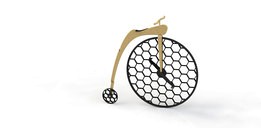
The Penny Silva
by GrabCAD
Last crawled date: 1 year, 10 months ago
The Penny Silva is a 3-D printed disposable bike, styled in the fashion of the classic Penny Farthing bicycles of old, for use in the urbanised centres of towns and cities of the year 2040. The bike would be printed using natural, bio-degradable cellulose for the frame, and a bio-degradable flexible polymer for the wheels and seat (links below). The bike starts breaking down rapidly after being printed, with a maximum usable life of 1 week. After this point, the bike’s structure begins to break down and disintegrate.
The theory is that 3D printing machines will be available to every family by the year 2040. If someone wants to travel a relatively short distance, they can print off one of these bikes with flower seeds (daisy, daffodil etc) embedded into the frame of the bike during the printing process. The user then travels to the desired destination, and discards the bike when it is no longer needed. After a period of no more than a week, the entire bike begins to decompose, exposing the pre-embedded flower seeds to the elements. After watering (or rain) the seeds begin to grow, creating a natural beauty in the undoubtedly grey, metallic cityscapes of the year 2040.
This concept is all about contrast. The contrast between the metal, glass and concrete materials of future cites and buildings, and the natural, degradable cellulose of the bike frame coupled with the delicateness of the budding flowers. The contrast between sleek, smooth future cars and buses, powered by electricity or petrol, and the man-powered, slightly awkward looking Penny Silva bike which harks back to the very early days of bicycle design.
The Penny Silva name originated from combining the words “Penny Farthing” and the word “Silva”, which means “growth” in Latin.
Style:
• The “Penny Farthing” form is quite attractive and classic. The proportions of the front to the back wheel, and the large sweeping arc the frame must make to join the two are quite visually appealing. Given the time period in which these bikes were popular, this form is undeniably classic, and would provide a welcome contrast to the modern and futuristic architecture and design of the heavily urbanised cities of the year 2040.
• Unlike more conventional style of bicycle, there are minimal moving parts. This is because the pedals are directly linked to the driving wheel, meaning there are no chains, cogs or gears to contend with, all of which are possible failure points for a product which will be fully 3D printed in a rapidly bio-degradable material.
• The honeycomb shape to the wheels has two purposes. The first is so that the wheels can absorb some impact and provide a small level of comfort for the user. The second is so to provide a structure which, when the flowers bloom, will
• The frame is a nod to the style of imitation petrol tank found on some classic Schwinn bikes.
• The golden ratio was used to determine the spacing between the front and back wheels, and also the size of the rear wheel.
Features:
• Seed-impregnated cellulose is used for the frame, a natural, rapidly bio-degradable material which is 3D printed and has no ill effect on the natural environment as it degrades.
• Seed-infused flexible Polymer is used for the wheels, which, coupled with the hexagonal construction, offers the rider a degree of comfort while cycling.
• The design is very slim, meaning time spent 3D printing is minimised. The use of snap-fits means the bike is easily assembled.
• A bag hook is cut into the frame to provide somewhere for rucksacks/laptop bags to attach to while cycling.
Link for biodegradable polymer: http://www.engineeringnews.co.za/article/biodegradable-polymers-show-new-flexibility-2005-12-16
Link for cellulose 3D printing:
http://www.wired.com/design/2012/11/3d-printer-wood-filament/
The theory is that 3D printing machines will be available to every family by the year 2040. If someone wants to travel a relatively short distance, they can print off one of these bikes with flower seeds (daisy, daffodil etc) embedded into the frame of the bike during the printing process. The user then travels to the desired destination, and discards the bike when it is no longer needed. After a period of no more than a week, the entire bike begins to decompose, exposing the pre-embedded flower seeds to the elements. After watering (or rain) the seeds begin to grow, creating a natural beauty in the undoubtedly grey, metallic cityscapes of the year 2040.
This concept is all about contrast. The contrast between the metal, glass and concrete materials of future cites and buildings, and the natural, degradable cellulose of the bike frame coupled with the delicateness of the budding flowers. The contrast between sleek, smooth future cars and buses, powered by electricity or petrol, and the man-powered, slightly awkward looking Penny Silva bike which harks back to the very early days of bicycle design.
The Penny Silva name originated from combining the words “Penny Farthing” and the word “Silva”, which means “growth” in Latin.
Style:
• The “Penny Farthing” form is quite attractive and classic. The proportions of the front to the back wheel, and the large sweeping arc the frame must make to join the two are quite visually appealing. Given the time period in which these bikes were popular, this form is undeniably classic, and would provide a welcome contrast to the modern and futuristic architecture and design of the heavily urbanised cities of the year 2040.
• Unlike more conventional style of bicycle, there are minimal moving parts. This is because the pedals are directly linked to the driving wheel, meaning there are no chains, cogs or gears to contend with, all of which are possible failure points for a product which will be fully 3D printed in a rapidly bio-degradable material.
• The honeycomb shape to the wheels has two purposes. The first is so that the wheels can absorb some impact and provide a small level of comfort for the user. The second is so to provide a structure which, when the flowers bloom, will
• The frame is a nod to the style of imitation petrol tank found on some classic Schwinn bikes.
• The golden ratio was used to determine the spacing between the front and back wheels, and also the size of the rear wheel.
Features:
• Seed-impregnated cellulose is used for the frame, a natural, rapidly bio-degradable material which is 3D printed and has no ill effect on the natural environment as it degrades.
• Seed-infused flexible Polymer is used for the wheels, which, coupled with the hexagonal construction, offers the rider a degree of comfort while cycling.
• The design is very slim, meaning time spent 3D printing is minimised. The use of snap-fits means the bike is easily assembled.
• A bag hook is cut into the frame to provide somewhere for rucksacks/laptop bags to attach to while cycling.
Link for biodegradable polymer: http://www.engineeringnews.co.za/article/biodegradable-polymers-show-new-flexibility-2005-12-16
Link for cellulose 3D printing:
http://www.wired.com/design/2012/11/3d-printer-wood-filament/
Similar models
thingiverse
free

Penny Silva Bike by chipd
...mers-show-new-flexibility-2005-12-16
link for cellulose 3d printing:http://www.wired.com/design/2012/11/3d-printer-wood-filament/
3d_export
$18

Penny Farthing Bicycle 3D Model
...cycles hi-wheel transport transportation cycles bike antique vintage retro
penny farthing bicycle 3d model firdz3d 83652 3dexport
3dwarehouse
free
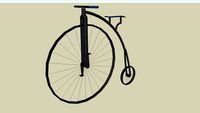
penny-farthing bicycle
...penny-farthing bicycle
3dwarehouse
an old fashioned bicycle #bicycle #bike #farthing #penny #transport
3d_export
$30

Penny Farthing Bicycle 3D Model
...tro model pedal bike old-fashioned cycling antique style vintage circus
penny farthing bicycle 3d model lance.lott 86818 3dexport
3d_ocean
$19

Penny farthing bicycle
...n
3d model of penny farthing bicycle .object are grouped.rendering scene with,materials are include and detailed, with all files.
cg_trader
$20
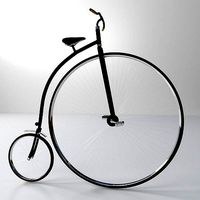
Penny Farthing Bicycle
...penny farthing bicycle
cg trader
penny-farthing bicycle
=========================
cg_trader
free

Penny Farthing 1870s the high-wheel bicycle
... high-wheel bicycle
cg trader
penny farthing 1870s: the high-wheel bicycle.simple modeling , materials and render in mental ray.
3d_sky
free

Penny farthing bicycle-
... penny farthing
bicycle penny farthing. 51925 polygons. materials and tekstrury in the archive. the model is made from the photo.
cg_trader
$11
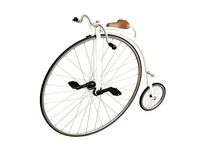
Bike Penny Farthing
...bike penny farthing
cg trader
bike penny farthing
grabcad
free

PENNY FARTHING BICYCLE
...penny farthing bicycle
grabcad
inventor 3d model of a vintage penny farthing bicyle.
Silva
3ddd
$1

SILVA Vario PP11876-RT
...silva vario pp11876-rt
3ddd
silva , vario
silva vario pp11876-rt
3ddd
$1

SILVA Vario UT11223-PT
...silva vario ut11223-pt
3ddd
silva , vario
silva vario ut11223-pt
3ddd
$1

SILVA Vario UT11315-PI
...silva vario ut11315-pi
3ddd
silva , vario
silva vario ut11315-pi
3ddd
$1

SILVA Vario UT11124-PI
...silva vario ut11124-pi
3ddd
silva , vario
silva vario ut11124-pi
3ddd
$1

SILVA Vario UT11625-BB
...silva vario ut11625-bb
3ddd
silva , vario
silva vario ut11625-bb
3ddd
$1

SILVA Vario UT11322-BA
...silva vario ut11322-ba
3ddd
silva , vario
silva vario ut11322-ba
3ddd
$1
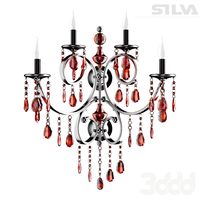
SILVA Vario PP11487-ER
...silva vario pp11487-er
3ddd
silva , vario
silva vario pp11487-er
3ddd
$1

SILVA Vario UT11368-RT
...silva vario ut11368-rt
3ddd
silva , vario
silva vario ut11368-rt
3ddd
$1

SILVA Vario UT11441-01
...silva vario ut11441-01
3ddd
silva , vario
silva vario ut11441-01
3ddd
$1

SILVA Vario UT11544-P1
...silva vario ut11544-p1
3ddd
silva , vario
silva vario ut11544-p1
Penny
turbosquid
$15

Spongebob Penny
...id
royalty free 3d model spongebob penny for download as stl on turbosquid: 3d models for games, architecture, videos. (1167875)
turbosquid
$10

Penny ottoman
...yalty free 3d model penny ottoman for download as obj and fbx on turbosquid: 3d models for games, architecture, videos. (1228848)
3ddd
$1

cattelan italia penny
...cattelan italia penny
3ddd
барный , cattelan italia
барный стул cattelan italia penny
turbosquid
$22

Heny Penny
... available on turbo squid, the world's leading provider of digital 3d models for visualization, films, television, and games.
turbosquid
$17

Penny Farthing
... available on turbo squid, the world's leading provider of digital 3d models for visualization, films, television, and games.
3ddd
$1

Pennie Sofa
...pennie sofa
3ddd
contemporary
hope u like it ^^
3ddd
$1

Penny Rose Sandals 02
...penny rose sandals 02
3ddd
обувь
limited edition penny rose sandals.
design by andre lb vieira
turbosquid
free

Penny Tails Side
... available on turbo squid, the world's leading provider of digital 3d models for visualization, films, television, and games.
turbosquid
free

Penny Heads Side
... available on turbo squid, the world's leading provider of digital 3d models for visualization, films, television, and games.
3ddd
$1

GLOBE ZERO 4 / PENNY
...be zero 4 / penny
3ddd
globe zero 4 , om
globe zero 4 penny side table
www.globezero4.dk
